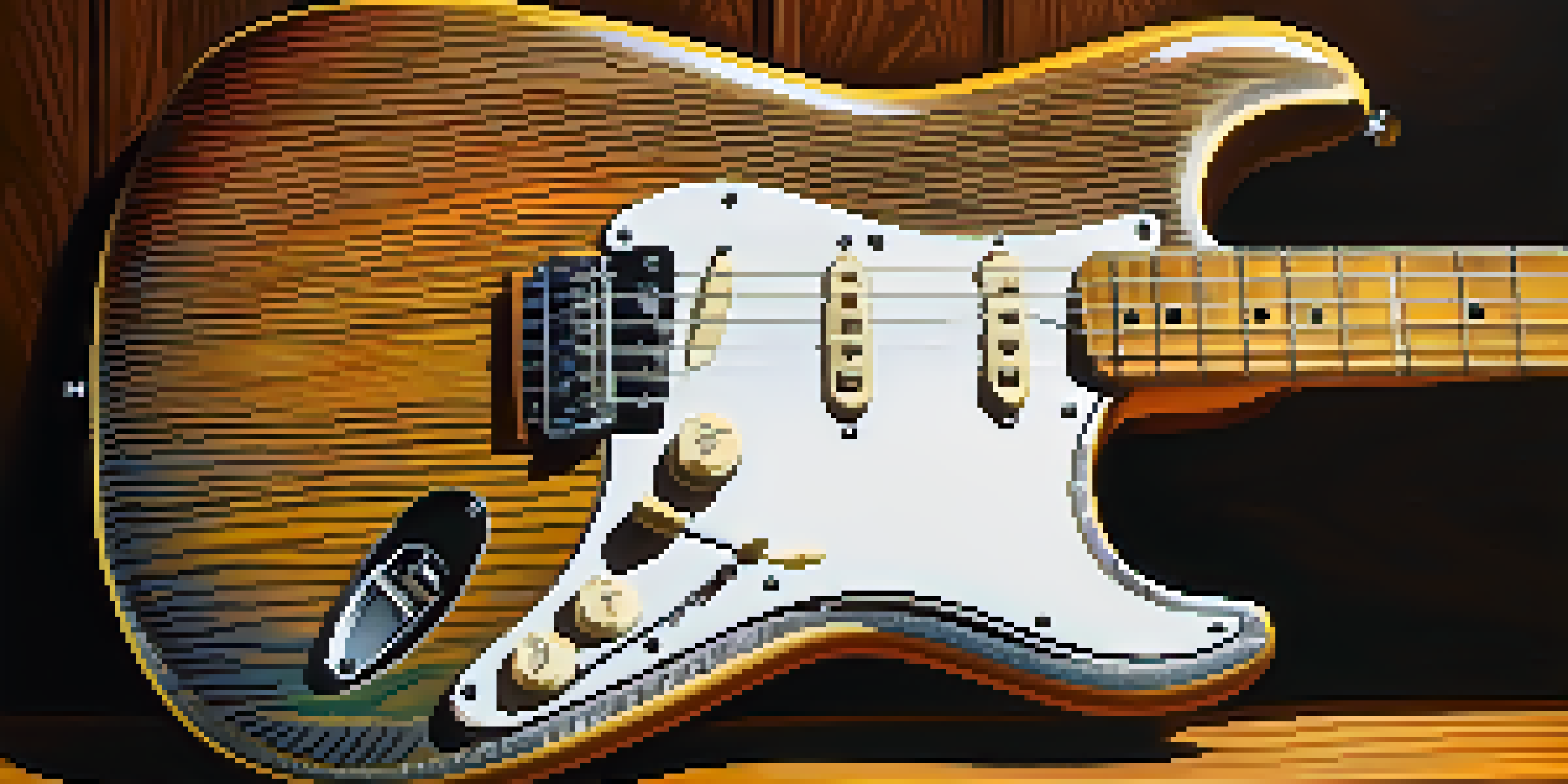The Evolution of Guitar Playing Through Stevie Ray Vaughan

Stevie Ray Vaughan: A Guitar Legend Emerges
Stevie Ray Vaughan, often referred to as SRV, burst onto the music scene in the early 1980s, quickly becoming a household name in blues-rock. His unique style combined elements of Texas blues, rock, and jazz, captivating audiences worldwide. Vaughan's passion for the guitar was evident from a young age, influenced by legendary musicians like Jimi Hendrix and B.B. King.
I don't play the guitar for anyone else. I play it for myself.
His debut album, 'Texas Flood,' showcased his incredible talent, drawing attention not just for his technical prowess but also for his emotional depth. Vaughan's ability to blend melodic lines with powerful riffs set a new standard for guitarists, inspiring countless musicians to explore the blues genre. SRV didn't just play the guitar; he brought it to life, making each note tell a story.
In a time when rock was shifting towards glam and pop influences, Vaughan’s raw sound was a breath of fresh air. His impact on guitar playing is undeniable, as he paved the way for a resurgence of blues in popular music, proving that emotion and authenticity resonate more than mere technical skill.
Innovative Techniques and Signature Sounds
Vaughan's guitar playing was characterized by a mix of intricate fingerpicking and heavy use of distortion, creating a rich, full-bodied sound. He was known for his aggressive attack on the strings, which added a unique texture to his music. Techniques such as string bending, staccato picking, and the use of feedback became hallmarks of his style, influencing future generations of guitarists.

His use of the Fender Stratocaster, particularly with heavy gauge strings, allowed him to achieve a sound that was both sharp and warm. Vaughan often employed various effects pedals, such as wah and overdrive, to further enhance his tone. This innovative approach to equipment and technique encouraged other musicians to experiment and find their own unique sounds.
Vaughan's Emotional Guitar Playing
Stevie Ray Vaughan's music was defined by his emotional connection to the guitar, making each performance deeply impactful and relatable.
Moreover, Vaughan's improvisational skills were top-notch. His ability to weave complex solos on the spot not only showcased his technical abilities but also his deep understanding of music theory, allowing him to push the boundaries of traditional guitar playing.
Blending Genres: Blues, Rock, and Beyond
One of the most remarkable aspects of Vaughan’s music was his ability to blend various genres seamlessly. While he rooted his playing in blues, he incorporated elements of rock, jazz, and even funk, creating a sound that was uniquely his own. This genre-blending opened up new possibilities for guitarists and broadened the audience for blues music.
The blues is a feeling; you have to feel it to play it.
Songs like 'Pride and Joy' featured catchy melodies paired with intricate guitar work, appealing to both blues purists and rock fans alike. Vaughan's versatility allowed him to perform with a wide range of artists from different musical backgrounds, further showcasing his adaptability and broad appeal. His collaborations with musicians like David Bowie and Jackson Browne demonstrated his ability to cross genre boundaries effortlessly.
This fusion of styles not only made Vaughan a standout musician but also influenced the evolution of guitar playing itself. His willingness to experiment encouraged others to incorporate diverse influences into their own music, leading to a richer, more eclectic sound in the guitar world.
The Emotional Connection in His Playing
What truly set Vaughan apart was his emotional connection to the music. Each note he played was infused with passion and intensity, drawing listeners into his performances. This emotional depth is what made his guitar solos so compelling and memorable, transcending mere technical skill.
Vaughan often drew from his personal experiences, channeling his struggles and triumphs into his music. Tracks like 'Love Struck Baby' showcased his ability to convey joy, while 'Texas Flood' expressed a deep sense of yearning. This authenticity resonated with audiences, making his music relatable and impactful.
Genre-Blending Musical Style
Vaughan seamlessly blended blues with rock, jazz, and funk, creating a unique sound that broadened the appeal of blues music.
By connecting emotionally with his guitar, Vaughan taught other musicians the importance of feeling in their playing. He demonstrated that a heartfelt performance could leave a lasting impression, influencing aspiring guitarists to strive for emotional authenticity in their own work.
Live Performances: A Transformative Experience
Stevie Ray Vaughan's live performances were legendary, often described as transformative experiences for those lucky enough to witness them. His energetic stage presence, combined with his technical skills, created an atmosphere that was electric. Vaughan's ability to engage with the audience made each show feel personal, as if he were playing just for them.
His concerts featured extended jams and improvisations, showcasing his creativity and spontaneity. This willingness to explore new musical ideas in real-time kept audiences on the edge of their seats, eagerly anticipating where he would take the music next. Vaughan’s performances were not just concerts; they were a celebration of the blues, inviting all to join in.
These unforgettable live shows have inspired countless guitarists to prioritize the live experience in their own careers. Vaughan's legacy serves as a reminder that music is not just about the notes played but also about the connection forged with the audience during moments of shared emotion.
Influence on Future Generations of Guitarists
Stevie Ray Vaughan's influence on guitarists cannot be overstated. Musicians from various genres cite him as a primary inspiration, emulating his techniques and emotional playing style. Guitarists such as John Mayer, Joe Bonamassa, and Gary Clark Jr. have all acknowledged Vaughan's impact on their music.
Vaughan's distinctive sound and innovative approach to the guitar have become benchmarks for aspiring players. Many guitarists study his solos, analyzing the nuances of his techniques to incorporate into their own playing. The 'SRV' style has become a goal for many, representing a blend of technical skill and emotional depth.
Influence on Future Guitarists
Vaughan's innovative techniques and authentic expression have inspired countless guitarists, shaping the future of guitar playing.
Beyond technique, Vaughan's emphasis on authenticity and expression has left a lasting legacy in the music world. His ability to convey raw emotion through his guitar serves as a guiding principle for musicians, encouraging them to find their own voice and share their stories through their art.
The Lasting Legacy of Stevie Ray Vaughan
Despite his untimely passing in 1990, Stevie Ray Vaughan's legacy continues to thrive. His music remains influential, with new generations discovering his work and being captivated by his talent. Vaughan's recordings and live performances are frequently revisited, serving as a source of inspiration for both seasoned musicians and newcomers alike.
The annual Stevie Ray Vaughan tribute concerts and the continued popularity of blues festivals highlight the enduring impact he has had on the music community. His contributions have not only revitalized interest in the blues genre but have also inspired a sense of camaraderie among musicians and fans alike.

Vaughan's story is a testament to the power of music and its ability to transcend time. His evolution as a guitarist, combined with his emotional connection to his craft, ensures that he will always be remembered as a pivotal figure in the world of guitar playing.